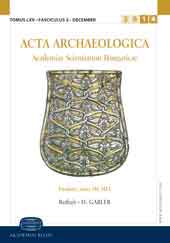Evolution and environment of the eastern linear pottery culture: A case study in the site of Polgár-Piócási-Dűlő
Evolution and environment of the eastern linear pottery culture: A case study in the site of Polgár-Piócási-Dűlő
Author(s): Emese Nagy, Małgorzata Kaczanowska, Janusz K. Kozłowski, Magdalena Moskal-del Hoyo, Maria Lityńska-ZającSubject(s): Anthropology, Archaeology, Cultural history
Published by: Akadémiai Kiadó
Keywords: Eastern Linear Pottery Culture; Polgár island; Middle Neolithic settlement; lithic analyses; anthracology;
Summary/Abstract: A salvage excavation preceding a major investment project was conducted in 2006–2007, during which associated settlement features of a Middle Neolithic, Eastern Linear Pottery Culture (Alföld Linearbandkeramik — ALBK) were uncovered in an area called Piócási-dűlő on the eastern outskirts of Polgár. The features of the ALBK settlement date from two periods. The cluster of multi-functional pits yielding a rich assortment of finds, the handful of post-holes and an unusual ritual well found in the southern part of the investigated area formed one unit from the earliest phase of the Middle Neolithic (ALBK I). The settlement’s other occupation can be assigned to the late phase of the Middle Neolithic (ALBK IV). Five houseplans representing the remains of timber-framed buildings outlined a distinct area with three multi-functional pits. Associated with the above features were 8 burials.The preliminary archaeobotanical results from Polgár-Piócási-dűlő are based on the plant material found within the sediments of 11 archaeological structures, which mainly represent pits and a welI. It can be stated that the natural environment offered habitats in which oak trees dominated in the local vegetation, forming floodplain forests and wooded steppes. They also provided food in the form of fruits and formed an optimal habitat for domestic animals. Arable fields were probably also established in the vicinity of the settlements, suggested by findings of macroscopic plant remains that represented cultivated species.In both settlement phases lithic production activities are manifested both by the local on-site lithic production and — most importantly — by the presence of imported, mainly mesolocal, raw materials that point to contacts with deposit areas, or off-site preliminary working of obsidian and limnoquartzites. The kit of harvesting tools and a large number of grinding stones — especially in the younger phase — for the preparation of plant food suggest a major role of plant cultivation.
Journal: Acta Archaeologica Academiae Scientiarum Hungaricae
- Issue Year: 65/2014
- Issue No: 2
- Page Range: 217-283
- Page Count: 67
- Language: English
- Content File-PDF

